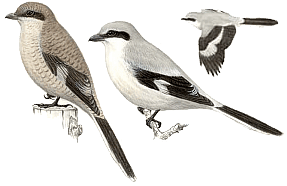|
|
| Main |
| Systematic List |
| Photo |
| Central Siberia |
| Guest book |
| Awards |
| SEARCH |
|---|
|
|
Laniidae |
|---|
Great Grey Shrike Lanius excubitor Linnaeus, 1758
|
According to Stepanyan (1990), four subspecies of the Great Grey Shrike occur in Central Siberia. Two of them, the Common Great Grey Shrike (L. e. excubitor) and the North Siberian Shrike (L. e. sibiricus) inhabit the extreme northern taiga as well as the forest-tundra, where they are mainly found in shrubby thickets in river valleys and in lake basins. These are probably the two subspecies that occupy the upper forest zone in the Evenkian mountains. The range of the Steppe Shrike (L. e. homeyeri), with its distribution centre to the west, extends into the southern pan of Central Siberia along the southern edge of the forest north up to the Minusinsk depression. The fourth subspecies, the Altai Shrike (L. e. mollis) is found in the West Sayan Mountains in the deciduous forest belt as well as in the forest-steppe of the foothills. Evidence suggests that in mid taiga the Great Grey Shrike nests in small numbers along bog edges and in swampy open forests. A. B. Kozlenko found a family group on July 31, 1976, in the southern part of the subzone in the middle section of the Malaya Khoyba River. The adult birds were feeding heir four fledglings with lizards at the edge of a bog within a sphagnum-carpeted pine forest. Further breeding records are reported for the Bakhta River, for a bog in the Varlamovka basin, and for Mimoye. Several individuals also occurred at the latter site during migration. Between May 8 and 12 and again between September 7 and October 6, Great Grey Shrikes were observed seeking flocks of Homed Larks feeding along the Yenisey banks. Two young birds caught on September 23, 1987, were in the final stages of their autumn moult. We have not registered any breeding Great Grey Shrikes in the Yenisey Southern taiga, although a single bird was observed at the end of July and beginning of August 1975 near Fomka (60°10' N) (Bursky and Vakhrushev 1983). Furthermore, one breeding pair was found on the middle reaches of the Kef River on the western border of the Krasnoyarsk Territory (Moskvitin et al.1977). It is unlikely that the suspicion of a gap between the distribution of the northern and southern subspecies in the Yenisey basin can be substantiated. Rather, it is more probable that isolated breeding sites found in specific habitats — edges of large bogs, swampy open forests, and bum sites — are typical of its distribution across the whole of the taiga zone. The individual records allow the conclusion that the species is rare everywhere. We discovered breeding shrikes in Yenisey extreme northern taiga at Angutikha (66°10' N) (Rogacheva and Vakhrushev 1983). A. V. Krechmar found it in the Norilsk valley near Keta Lake, on the upper reaches of the Rybnaya River, and in the basin of the Khantayka River (Krechmar 1966). Other records include Yu. G. Puzachenko who found a Great Grey Shrike on the Syverma plateau on the Arctic Circle (Puzachenko 1968) and 0. A. Chernikov who discovered a female feeding a fledgling with almost fully grown primaries along the Nizhnyaya Tunguska River in the northern part of the mid taiga in the summer of 1986. The Great Grey Shrikes we observed in the Yenisey forest-tundra between 68° and 69° N bred in open forests near Nikolskoye and Ust'-Khantayka (Rogacheva et al. 1983). I. I. Chupin recorded breeding shrikes in open larch forests in the Ary-Mas Reserve in the shrub tundra subzone at 72°30' N in 1981 and again in 1983 (Chupin 1987). This proved to be the most northern breeding record for the species in Central Siberia. There is almost no data in the literature on breeding records or even on observations whatsoever for the southern subspecies. P.P. Sushkin reported breeding Steppe Shrikes at the turn of the century in forest-steppe and on taiga edges in the Minusinsk depression (Sushkin 1914). According to Prokofyev (1987), the species is rare in the Minusinsk depression. It was recorded in the Krasnoyarsk forest-steppe, in subtaiga, and in southern taiga north to Yeniseysk and east to the limits of the Yeniseysk Province, i.e., the Mura River (Tugarinov and Buturlin 1911). The only indication of the presence of the Altai Shrike in an area near Central Siberia was provided by A.I. Yanushevich, who caught a specimen in Tuva at the Kady-Kholun River in the stony Caragana steppe (Yanushevich 1952). |
[Back] |
|
|
|
|
Сайт разработан и поддерживается кафедрой прикладной экологии и ресурсоведения СФУ
